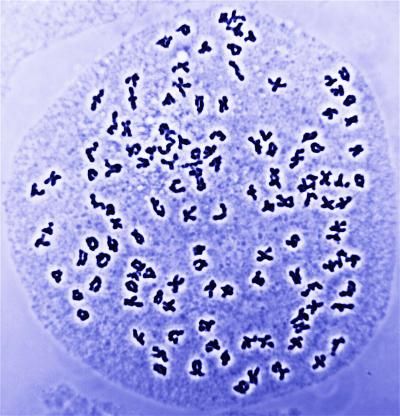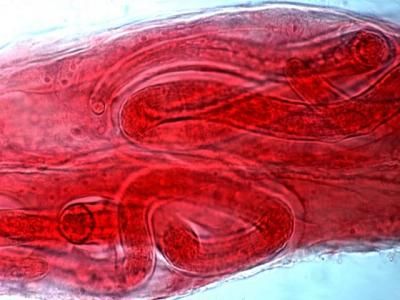Genome duplication responsible for more plant species than previously thought
Advertisement
Extra genomes appear, on average, to offer no benefit or disadvantage to plants, but still play a key role in the origin of new species, say scientists from Indiana University Bloomington and three other institutions in Proceedings of the National Academy of Sciences .

Polyploidy is important in the origin of new plant species and has caused some species to have an astoundingly large number of chromosomes. This photograph is a "chromosome squash" of a hexaploid (six genome copies) fern species of the genus Cystopteris. This species has 126 pairs of chromosomes.
Michael Windham
Plant biologists have long suspected polyploidy - the heritable acquisition of extra chromosome sets - was a gateway to speciation. But the consensus was that polyploidy is a minor force, a mere anomaly that accounts for 3 or 4 percent of the world's flowers and ferns. The first direct, comprehensive survey of polyploid speciation in plant evolution severely challenges that notion.
"In the present paper, we make it clear that it is a common process," said evolutionary biologist and lead author Troy Wood, who began the research during graduate training at IU Bloomington. "Fifteen percent of flowering plant species and almost a third of fern species are directly derived from polyploidy."
Could polyploidy provide plants with a powerful advantage over their chromosome-challenged peers? Not necessarily. The scientists' exhaustive survey of published phylogenetic and genomic data also shows that plant lineages starting with a polyploid ancestor appear to be no more successful at spawning species than diploid plants, which have two sets of chromosomes.
"The fact that polyploidy seems to have no effect on diversification rates should reduce the number of enthusiastic commentaries about the 'advantages of polyploidy,'" said IU Bloomington evolutionary biologist and paper coauthor Loren Rieseberg, who supervised the research. "However, our diversification rate analyses only examined recent polyploids. A future area of research should be to ask whether more ancient polyploidy events have increased diversification rates."
While the variation that leads to new species is usually a glorious accident, evolutionary biologists are beginning to identify the biological properties of organisms that make those accidents stick around long enough for new species to become established. If whatever separates the new breed from its original population is tenuous, it's possible the new and old populations will comingle, negating the possibility of a new species. Geographic separation or "reproductive isolation" is crucial.
Polyploidy can also result in speciation, as polyploid individuals often cannot produce viable offspring with their diploid (two sets of chromosomes) relatives. While the polyploid and diploid individuals may appear more-or-less identical to one another, their genetics make sexual reproduction unlikely or impossible.
Plants are pretty special. Not only can many species tolerate extra chromosome sets, but polyploidy appears to be a recurring theme throughout plant evolution. The question is why.
"Recent data reveal evidence of polyploidy in an array of plants, like grapes, poplar trees, corn, and many others," Wood said. "In most of these cases the evidence points to ancient polyploid events. Some species of flowering plants have more than 400 chromosomes and some fern species more than 1,000 due to repeated instances of polyploidy during their evolution. While these examples might seem remarkable, given the high frequency of polyploidy speciation documented here, the bigger surprise would be if plant lineages were found in which polyploidy was absent."



















































